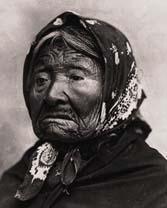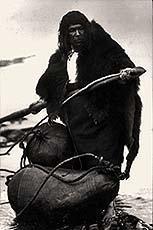By Sharon Boswell
and Lorraine McConaghy
Special to The Times
Princess Angeline. Photo credit: Seattle Times.
 A TEAM OF JET BLACK HORSES DREW THE CUMBERSOME HEARSE, leading the funeral procession
as it wound along the road from Our Lady of Good Help Catholic Church to Lakeview Cemetery, overlooking Seattle.
A TEAM OF JET BLACK HORSES DREW THE CUMBERSOME HEARSE, leading the funeral procession
as it wound along the road from Our Lady of Good Help Catholic Church to Lakeview Cemetery, overlooking Seattle.
All of the city's most prominent residents had turned out on this warm June day in 1896
to pay their last respects to Princess Angeline, the daughter of Chief Sealth of the Suquamish. Another
crowd of mourners -- just plain folks -- lined the route, silently acknowledging the passing of an era.
Princess Angeline had been a Seattle fixture -- a strong-willed woman whose care-worn yet
dignified face could barely be glimpsed beneath the calico scarf and woolen shawl she always wore. Yet she was
instantly recognizable as she hobbled with staff in hand along Seattle's waterfront or sold hand-made baskets
with other Indian women on downtown street corners. Angeline's dilapidated cabin at the end of Pike Street was
a bleak reminder of Indian encampments that once stretched along the tideflats of Elliott Bay.
Photographer Edward Curtis had built a reputation in Seattle for his portraits of society matrons,
but became fascinated with Indians when he saw Angeline digging clams along the shore. He paid her a dollar
for every picture she allowed him to shoot, and soon expanded his subjects, launching what became his life's work:
the photographic documentation of North American Indians. As he later told a Seattle Times reporter, he
hoped to leave a visual record "of the peculiar ethnic traits of this fast vanishing race."
By the time of Angeline's death, most Seattleites joined Curtis in the belief that the Puget
Sound Indian peoples' way of life was, indeed, vanishing. Yet their nostalgic laments for the past were a
convenient fiction, ignoring the frequent discord between Indians and newcomers. From earliest encounters,
traders and settlers had relied on Indians for necessary supplies, but clashed with them over land and values.
Although some Indians, including Sealth, had continued as friends and providers, others
became openly hostile. Violence had resulted, culminating in a short war in 1856. Only isolated clashes marked
the next few decades, but Seattle's growing population remained ambivalent to its Indian neighbors.
One edition of a local newspaper might refer to Indian peoples with disdainful epithets; the next could
lament this "dying race."
 Whale hunter. Ed Curtis for The Seattle Times.
Whale hunter. Ed Curtis for The Seattle Times.
OTHER NEWS ITEMS SHOWED THAT THE INDIANS OF PUGET SOUND
continued to play an integral
role in the economic life of the community. The Makah, Quileute and other coastal peoples, who had long
relied on the sea for their subsistence, moved into commercial whaling and sealing.
Each fall during the harvest season, native families from throughout the region came by boat or
rail to work in the hopfields that spread along King County's river valleys. A few even homesteaded
their own parcels on these fertile floodplains.
And well into the 20th century, canoes lined the Seattle waterfront as Indian
fishermen sold salmon and shellfish to local processors, while Indian crews worked in nearby
logging camps, sawmills and mines.
Sealth, the beloved chief who had helped the early settlers, became a symbol of friendly
Indian relations -- so much so that Seattle's founders proudly named the city after him.
Years later, the city tried to create another symbol of respect for the region's
Indian heritage by erecting a totem pole in the small triangular park at the heart of the pioneer district.
But from the day the pole was unveiled in 1899, controversy swirled around it. The excursion party that had
donated the totem to the city was accused of stealing it from a small Alaskan Indian village. The Pioneer
Place pole was a deeply flawed icon, commemorating little except the deep misunderstandings between
newcomers and Indian peoples.
Historians Sharon Boswell and Lorraine McConaghy teach at local universities and do research, writing and oral history. Original newspaper graphics courtesy of the Seattle Public Library.